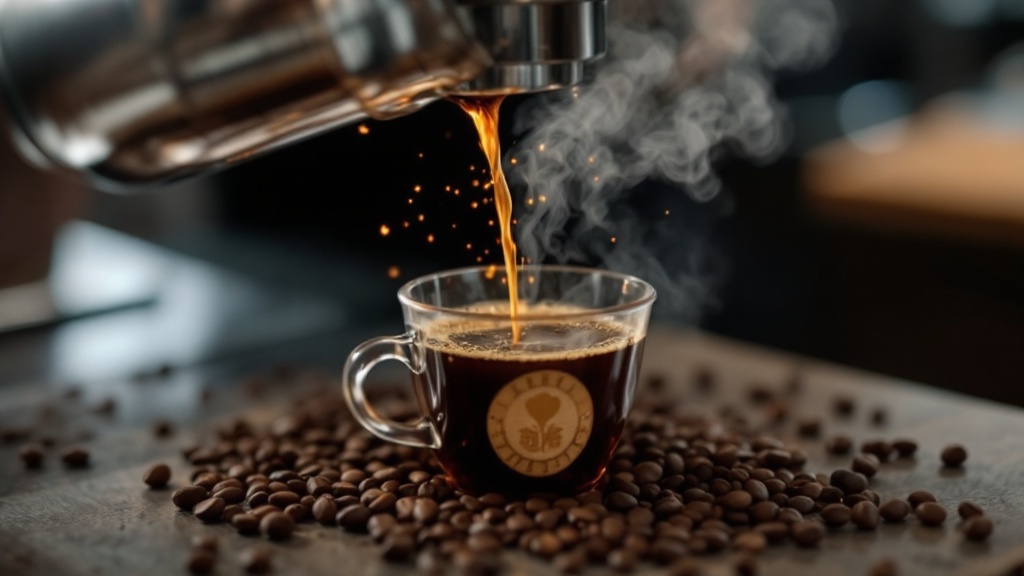In today’s fast-paced world, the quest for an extra energy boost is a common pursuit. For many, the answer lies in a steaming cup of coffee. But what if your regular brew just isn’t cutting it? Enter the realm of high-caffeine coffee, a potent elixir designed to supercharge your day. This article delves into the fascinating world of high-octane coffee, exploring its origins, the science behind its power, and the brands pushing the boundaries of caffeine content.
- The Caffeine Conundrum: Understanding the Basics
- From Bean to Buzz: The Rise of High-Caffeine Coffee
- The Caffeine Arms Race: Navigating the High-Caffeine Landscape
- Brewing the Perfect Buzz: Techniques for High-Caffeine Extraction
- Beyond the Buzz: The Future of High-Caffeine Coffee
- Conclusion: Embrace the Buzz Responsibly
The Caffeine Conundrum: Understanding the Basics

Caffeine, a natural stimulant found in coffee beans, tea leaves, and cacao, is the driving force behind coffee’s energizing effects. The caffeine content in coffee isn’t static; it varies significantly based on several factors. The type of bean plays a crucial role, with Robusta beans boasting nearly double the caffeine (2.7%) compared to their Arabica counterparts (1.5%). This difference is why Robusta beans are often the foundation of high-caffeine blends and instant coffee (source). The roasting process also impacts caffeine levels; darker roasts tend to have slightly less caffeine than lighter roasts.
Beyond the beans themselves, the brewing method significantly influences the final caffeine concentration. Espresso, with its concentrated extraction, packs a punch of around 63 mg of caffeine per ounce. Drip coffee, a more common brewing method, typically contains 12-16 mg/oz. Plot twist, don’t let these numbers fool you; serving size ultimately determines the total caffeine intake. A large drip coffee can easily surpass the caffeine content of a single shot of espresso. This complexity highlights the importance of understanding both caffeine concentration and serving size when choosing your coffee.
Caffeine Extraction Methods
The brewing method significantly impacts caffeine extraction efficiency, influencing the final beverage’s caffeine concentration. Different methods vary in their extraction parameters, including temperature, pressure, brew time, and solvent-to-solid ratio (the ratio of water to coffee grounds). For instance, espresso extraction employs high pressure (typically 9 bars) and relatively short contact times (20-30 seconds) with finely ground coffee, leading to a highly concentrated extract. This high pressure forces water through the coffee grounds, extracting a significant amount of caffeine and other desirable compounds in a short period. The result is a concentrated shot with a higher caffeine-per-ounce concentration compared to other methods.
- Cold brew coffee uses a long, low-temperature extraction (12-24 hours), resulting in lower caffeine concentration per ounce but less bitterness.
- French press extraction, with its longer brew time and coarser grind, yields a higher caffeine content than drip coffee but less than espresso.
- Instant coffee undergoes a significant processing stage that alters its chemical composition, often resulting in a lower concentration of caffeine compared to other brewing methods.
- The type of coffee bean (Arabica vs. Robusta) also affects caffeine concentration; Robusta beans generally contain almost double the caffeine of Arabica beans.
- Beyond water, other solvents like supercritical CO2 can be used to extract caffeine, enabling decaffeination processes.
| Brewing Method | Caffeine (mg/oz) | Extraction Time | Pressure/Temp |
|---|---|---|---|
| Espresso | 63 | 20-30 sec | 9 bars |
| Drip Coffee | 12-16 | 5-10 min | Normal |
| Cold Brew | Lower | 12-24 hrs | Low temp |
| French Press | Higher than drip | 4-5 min | Normal |
From Bean to Buzz: The Rise of High-Caffeine Coffee

The story of high-caffeine coffee begins with the discovery of Robusta coffee (Coffea canephora) in the Congo Basin during the 19th century (source). Its resilience to pests and, importantly, its higher caffeine content quickly propelled it to prominence. The 20th century saw Robusta become a cornerstone of the instant coffee industry and a key ingredient in many energy drinks, driven by its affordability and potent caffeine kick.
While the specialty coffee movement of the 21st century initially focused on the nuanced flavors of Arabica beans, a niche market for high-caffeine Robusta blends has emerged. Brands like Death Wish Coffee, Black Insomnia, and Biohazard Coffee have staked their claim in this territory, marketing themselves as purveyors of the “world’s strongest coffee,” with caffeine levels reaching up to 1,500 mg per 12 oz serving. This resurgence of Robusta reflects a growing consumer demand for a potent caffeine fix, driven by students, professionals, and athletes seeking enhanced focus and energy.
Robusta Caffeine Content Variation
Caffeine concentration in <i>Coffea canephora</i> (Robusta) beans exhibits significant variability influenced by several factors. Genetic diversity within the species plays a crucial role, with different cultivars displaying inherent differences in alkaloid biosynthesis pathways. Environmental conditions during cultivation also exert considerable influence. Altitude, temperature, rainfall, and soil nutrient composition all interact to affect caffeine accumulation in the developing bean. Higher altitudes and lower temperatures generally correlate with higher caffeine concentrations, although the precise mechanisms underlying this relationship remain an area of ongoing research within fields like agricultural chemistry and plant physiology. These environmental variables impact the metabolic processes within the plant, influencing the rate of caffeine synthesis and accumulation.
- Caffeine levels can range from 2.0% to 2.5% by bean weight, significantly higher than Arabica.
- The cultivar Conilon, a common Robusta variety, generally shows higher caffeine content than other types.
- Processing methods (e.g., washed vs. natural) can subtly influence final caffeine concentration in the beans.
- Shade-grown Robusta tends to have lower caffeine levels compared to sun-grown beans.
- Soil composition, particularly nitrogen levels, can impact the plant’s alkaloid production and therefore caffeine content.
The Caffeine Arms Race: Navigating the High-Caffeine Landscape

The quest for the ultimate caffeine kick has led to a competitive landscape of high-caffeine coffee brands. Death Wish Coffee, a prominent player, boasts around 700 mg of caffeine per 12 oz cup. Black Insomnia, a competitor, claims an even higher caffeine content, pushing the boundaries with over 1,500 mg per serving. These extreme levels of caffeine cater to a specific consumer base seeking maximum stimulation. Plot twist, it’s crucial to approach these high-caffeine options with caution.
The FDA recommends a daily caffeine intake of no more than 400 mg for healthy adults (source). Exceeding this limit can lead to adverse effects, including anxiety, insomnia, and cardiovascular problems. When exploring high-caffeine coffee, it’s essential to be mindful of your individual tolerance and to consume responsibly. Start with smaller servings and monitor your body’s response before increasing your intake. Transparency in labeling is paramount; look for brands that clearly state the caffeine content per serving.
Caffeine Content Measurement
Accurate determination of caffeine content in coffee products is crucial for consumer safety and regulatory compliance. While manufacturers often provide caffeine levels per serving, these values can vary based on numerous factors impacting the extraction and concentration processes. These factors include the type of coffee bean (Arabica vs. Robusta, with Robusta containing significantly higher caffeine levels), roasting level (darker roasts generally contain slightly less caffeine due to thermal degradation), grind size (finer grinds typically extract more caffeine), brewing method (espresso extracts higher caffeine concentrations than drip brewing), and even the water temperature and brewing time. The lack of standardized testing methods across manufacturers also introduces variability in reported caffeine content.
- High-performance liquid chromatography (HPLC) is a common laboratory method for precise caffeine quantification.
- Variations in caffeine content can lead to inconsistencies in labeling and potential health concerns for sensitive individuals.
- Decaffeination processes don’t always remove 100% of caffeine; residual amounts can vary significantly.
- The caffeine content of tea, energy drinks, and other caffeinated beverages is also subject to similar variability.
- Government regulations often set limits on allowable caffeine levels in certain products.
Brewing the Perfect Buzz: Techniques for High-Caffeine Extraction

Achieving maximum caffeine extraction requires understanding the science behind brewing. Two methods stand out for their ability to deliver a concentrated caffeine hit: cold brew and espresso. Cold brew, with its extended steeping time (often 12-24 hours), extracts more caffeine from the grounds than traditional hot brewing (source). The lower temperature also results in a smoother, less acidic brew, appealing to those sensitive to traditional coffee’s bitterness.
Espresso, on the other hand, utilizes high pressure to force hot water through finely-ground coffee, resulting in a concentrated shot with a rich crema. This intense extraction method yields a higher caffeine concentration per ounce compared to drip coffee. Whether you prefer the slow, methodical process of cold brew or the quick, powerful punch of espresso, understanding these techniques allows you to tailor your brewing method to your desired caffeine level.
Espresso Extraction Kinetics
The high caffeine concentration achieved in espresso is not merely a consequence of high pressure, but rather a complex interplay of factors governed by extraction kinetics. The process involves the diffusion of soluble compounds, including caffeine, from the coffee grounds into the water. This diffusion is influenced by several key parameters, most notably temperature, pressure, and particle size. Higher temperatures increase the solubility of caffeine, allowing for a faster extraction rate. However, excessively high temperatures can lead to over-extraction, resulting in a bitter and astringent taste, and potentially degrading some desirable flavor compounds. The 90-96°C range is generally considered optimal for espresso extraction. Pressure, typically ranging from 9-10 bar in a commercial espresso machine, significantly enhances the extraction efficiency by forcing water through the tightly packed coffee bed, maximizing contact time with the grounds. Particle size uniformity is also crucial; a consistent grind size ensures even extraction throughout the puck, preventing channeling and ensuring a balanced espresso shot.
- Extraction time significantly impacts flavor; a shorter shot may be under-extracted (sour), while a longer shot risks over-extraction (bitter).
- Coffee bean variety and roast level influence the solubility of compounds, affecting extraction kinetics and the final cup’s characteristics.
- Water quality, including mineral content and pH, can subtly alter extraction and influence the final espresso’s taste.
- The grind size distribution, not just the average size, significantly impacts extraction uniformity. A wider distribution leads to uneven extraction.
- Different brewing methods (e.g., Aeropress, Moka pot) exhibit unique kinetic profiles due to variations in pressure, temperature, and contact time.
Beyond the Buzz: The Future of High-Caffeine Coffee

The world of high-caffeine coffee isn’t static. Researchers are exploring innovative ways to boost caffeine content naturally through genetic engineering (source). These advancements could lead to coffee plants producing beans with significantly higher caffeine levels, potentially revolutionizing the high-caffeine coffee market. Plus, new caffeine extraction techniques are being developed, allowing for the isolation of caffeine for use in pharmaceuticals and energy products.
Sustainability is also gaining traction in the high-caffeine coffee industry. Companies are increasingly focusing on ethically sourced Robusta beans, recognizing the importance of environmental and social responsibility. This shift towards sustainable practices is crucial for the long-term viability of the high-caffeine coffee market, ensuring that the pursuit of a potent brew doesn’t come at the expense of the planet or its people. As the demand for high-caffeine coffee continues to grow, these innovations and ethical considerations will shape the future of this stimulating beverage.
Robusta Caffeine Biosynthesis
Genetic engineering offers a promising avenue for increasing caffeine content in *Coffea canephora* (Robusta) beans. This approach typically involves manipulating genes responsible for caffeine biosynthesis within the plant’s chloroplasts and other relevant cellular compartments. The primary enzymes involved are N-methyltransferases (NMTs), specifically those responsible for the methylation steps in the purine alkaloid pathway leading to caffeine production. Overexpression of specific NMT isoforms, identified through transcriptomic and proteomic analysis of high-caffeine Robusta cultivars, is a common strategy. This can be achieved using various gene editing techniques, including CRISPR-Cas9 technology, allowing for precise targeting and modification of specific NMT genes. Successful gene editing requires careful selection of target sites to minimize off-target effects and ensure the stable integration of modified genes into the plant’s genome. The transformation process usually involves <i>Agrobacterium tumefaciens</i>-mediated gene transfer, followed by rigorous selection and regeneration of transgenic plants.
- Theophylline and theobromine are intermediate compounds in the caffeine biosynthesis pathway, also subject to manipulation.
- Downregulation of caffeine degradation enzymes can complement NMT overexpression for enhanced caffeine accumulation.
- Specific NMT isoforms, like CCaNMT1 and CCaNMT2, are prime targets for genetic modification in *Coffea canephora*.
- RNA interference (RNAi) can be used to silence genes involved in caffeine breakdown, further increasing caffeine content.
- Environmental factors like light intensity and nutrient availability can influence the effectiveness of genetic modifications.
- Regulatory hurdles and consumer acceptance are significant considerations for commercializing genetically modified Robusta coffee.
Conclusion: Embrace the Buzz Responsibly

High-caffeine coffee offers a powerful boost for those seeking enhanced focus and energy. From the robust Robusta bean to the innovative brewing techniques, the world of high-caffeine coffee provides a diverse range of options for caffeine enthusiasts. Plot twist, it’s crucial to remember that moderation is key. While a well-timed caffeine kick can be beneficial, excessive consumption can have negative consequences. By understanding the science behind caffeine, choosing your coffee wisely, and consuming responsibly, you can harness the power of high-caffeine coffee while safeguarding your health and well-being.
Caffeine’s Adenosine Antagonism
Caffeine’s primary mechanism of action involves its antagonism of adenosine receptors in the brain. Adenosine, a neurotransmitter, promotes relaxation and sleepiness; its binding to A<sub>1</sub> and A<sub>2A</sub> receptors inhibits the release of excitatory neurotransmitters like dopamine and glutamate. Caffeine, structurally similar to adenosine, competitively inhibits adenosine binding to these receptors. This competitive inhibition prevents the adenosine-mediated suppression of neuronal activity, leading to increased neuronal excitability and the subjective experience of alertness and enhanced focus. The affinity of caffeine for A<sub>2A</sub> receptors is particularly significant in mediating its psychostimulant effects.
- Caffeine’s binding to adenosine receptors is reversible; its effects wear off as caffeine is metabolized and eliminated.
- The A2Areceptor subtype is predominantly found in the striatum, a brain region crucial for motor control and reward processing, explaining some of caffeine’s effects on movement and motivation.
- Individual sensitivity to caffeine varies due to genetic factors influencing adenosine receptor density and caffeine metabolism rate.
- Chronic caffeine consumption can lead to the upregulation of adenosine receptors, requiring higher doses to achieve the same effect (tolerance).
- Beyond alertness, caffeine’s adenosine antagonism contributes to its diuretic effect by influencing kidney function.
| Key Aspect | Mechanism | Effects | Considerations |
|---|---|---|---|
| Caffeine’s Action | Antagonizes adenosine receptors | Increases neuronal excitability | Reversible binding, effects wear off |
| A2A Receptors | Found in striatum | Affects motor control, reward | Mediates psychostimulant effects |
| Individual Sensitivity | Genetic factors influence | Varies in receptor density, metabolism | Chronic use leads to tolerance |
| Diuretic Effect | Influences kidney function | Contributes to fluid loss | Linked to adenosine antagonism |


Interesting information very helpful
I’m definitely a coffee lover and looking forward to articles of this nature. Thank u.
What an eye-opening article! Not just well-written but very insightful! Well-done! (Former English teacher)